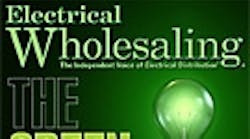The idea of energy efficiency as a sales opportunity for electrical wholesalers dates back to the gas crisis in the 1970s. But over the years, surprisingly few electrical distributors have made it a top priority. With lighting products accounting for at least 25 percent of their total sales, distributors have sold their share of energy-efficient products. But few companies have positioned themselves as the go-to guys and gals for the supply of energy-efficient products in their local market areas. The electrical distributors that have made the investment in the green market have quietly made a good living at it.
In many ways the green market has been left to niche distributors such as lighting specialists that focus on selling a package of energy-efficient lighting products; energy-service companies (ESCOs) that provide design, financing, supply and installation for large commercial and institutional buildings (focusing not only on energy-efficient lighting systems, but energy-efficient heating and air conditioning (HVAC) systems, energy-saving windows and doors, micro-generators and such); and the relative handful of full-line electrical distributors gung-ho about green.
All is not lost for full-line electrical distributors that want to get into the green market. In fact, the timing may have never been better. There's a revolution underway in the lighting market with the development of radically more efficient lamps. There's a bevy of federal energy legislation on the books in Washington that electrical professionals can use as a tool to create sales opportunities for green electrical products, and the Obama administration is on record as saying that it will push for even more investment in green technologies to loosen the nation's dependence on foreign oil.
This article presents 25 practical tips electrical distributors can use to become players in this market. In addition, Electrical Wholesaling's G-Biz Online at www.ewweb.com, offers free access to the best articles EW has written on the green market over the years; information on conferences, trade shows and other industry events in the green market; new products; and much more. This article will show you how to make green a reality for your company. To begin, focus on four key strategies.
-
Live green: Walking the talk
-
Learn green: Educating yourself and your employees about the resources available to you to grow your green market.
-
Market green: Building your identity as a green company with marketing, promotions and common sense.
-
Get ready for the future of green: Selling products for alternative energy source such as solar and wind.
An all-out commitment to going green may not be the right strategy for everyone, but few if any distributors, reps and manufacturers should walk away from the profits that can come from integrating some aspect of the green movement into their companies' operations or into the portfolio of products they sell. Want to learn more? Read on.
Living Green
1. Ask yourself how serious you are about going green
Are you serious enough about it to purchase electric, hybrid or propane vehicles for your sales force or truck drivers? Would you consider building your next new branch to green building standards? These are the kinds of questions you have to ask yourself if you really want to position yourself as the greenest distributor in the market. Sure, you can go miles short of these ambitious goals and still sell a ton of green products. But the big winners in this market will be the companies willing to walk the talk. As the saying goes, “Go big or go home.”
2. Gather your management team and ask yourselves some serious questions
If you are serious about staking out a new position as a leader in the green market, ask your management team these questions: What products, services or training in the green market do customers need but currently are not getting? What would it take to become the best provider of green electrical products in our market? Who is currently the top dog in green products in the market? Where are they strong? Where are they weak? What would it take to top them? Could we acquire them? If money were no object and we could hire anyone, who would be on our dream team to build the company's business in this market? If we were starting the company from scratch and could hand-pick our portfolio of green product lines, which companies would we want to do business with?
3. Use your facility to showcase the latest and greatest in energy efficiency
It's not a new idea for an electrical distributor to install different types of lighting systems in their offices, conference rooms, warehouses and counter areas to showcase the latest in energy-efficient lighting systems. But seeing is believing and your customers need to be able to compare the latest in lighting with standard-grade lighting — even down to ancient-but-still-out-there F40 cool white fluorescent lamps for office lighting. Install the lighting in a real-world environment, and compare various light bulbs side-by-side in lightboxes or lighting lab vignettes. Don't forget to install lighting meters that show how much each system costs to operate.
Frost, a distributor based in Maryland Heights, Mo., has made a major investment in the green market with its recently opened T.E.C. Center. Along with providing a state-of-the-art training center and a touch-and-feel experience for customers interested in industrial automation and voice-data-video (VDV) products, the facility demonstrates various lighting systems.
In a press release describing the facility, Claudia Gabay-Jones, Frost's Certified Lighting Consultant (CLC) and account manager, said the T.E.C. Center helps teach customers about the visible differences in how light sources render color. “We can also demonstrate the visual effects produced by the latest energy-efficient lighting products in their applications, plus showcase various energy-efficient lamp technology including T8, T5, metal-halide and LED lamps,” she said. “We also have the latest in emergency and exit sign technology on display, in addition to the newest lighting control systems and occupancy and daylight sensors.”
Additionally, Frost has dedicated itself to providing customers with the latest in environmentally friendly products and solutions through the launch of its “Green Choice” program. Customers will be able to easily identify green products displayed at various locations throughout the Sales Center. “We want to make it easy for customers to find the green products that they are looking for, while establishing ourselves as leaders in providing energy-efficient solutions,” said Jeff Frost.
4. Recycle your company's disposable paper, plastics, glass, packaging, cardboard — and have an onsite drop-off for customer recyclables
What better way to show your employees and customers that you are living green than to recycle? You can find out about what it takes to get a recycling dumpster from your local waste management company. For those recyclables that you can cash in, such as bulk paper or corrugated packaging, think about donating the proceeds to a local green cause — and then shamelessly self-promote the program to your customers and local media.
5. Offer a lamp recycling service for your customers
While we are talking about recycling, consider offering lamp recycling to your commercial customers. Any lamps that contain mercury, including the millions of fluorescent lamps that light virtually all offices, must be disposed of properly, according to federal, state and local waste disposal regulations. You can find out the specifics of these regulations at www.lamprecycle.org, a solid online resource developed by the National Electrical Manufacturers Association (NEMA), Rosslyn, Va. Lamp recycling companies often partner with distributors to get their recycling bins in the hands of end users so they can safely dispose of any lamps containing mercury.
According to Veolia Environmental Services, Lombard, Ill., more than 700 million lamps are discarded every year and only 25 percent are currently being recycled. Distributors sell the company's RecyclePak, a prepaid recycling program that allows customers to purchase containers, fill them with fluorescent lamps, and ship them back to the company's recycling facility using FedEx Ground at no additional cost. Veolia says its distributors make up to 40 percent margins by providing this service. To read EW's April 2007 cover story on how The Lighting Co., Irvine, Calif., is profiting from lamp recycling, type “Steve Espinosa getting serious about saving energy” into the search engine at www.ewweb.com.
Learning Green
6. Learn where the industry has been in marketing green electrical products and you may be able to better understand where it's going
Someone could write a book about the ups and downs of the green market in the electrical wholesaling industry. Some of the biggest factors include:
The development of the “pay more now for future savings” marketing mantra
Because the first generation of energy-efficient products had a much higher upfront cost than traditional products, manufacturers, distributors and reps quickly learned they had to use return-on-investment analyses to sell these products. That's still often the case. Today's carefully constructed payback analyses are software-based and figure in not only lamp life and unit cost, but local electricity rates, depreciation of lighting quality, and other key factors.
The rise of utility rebates
Another major milestone in marketing green electrical products was the use of utility rebates to offset the cost of installing energy-efficient electrical products. In the early 1990s, utilities were faced with major demand issues, and it was cheaper for them to cut demand than to build new power plants. Rebate programs were loaded with funds for products including electronic ballasts, T8 lamps, compact fluorescent lamps (CFLs), occupancy sensors, energy-efficient motors and variable-speed drives. These rebate programs took a hit when some utilities cut funding for them and when some users figured out how to scam the utilities, even going so far as to laser-print phony product labels for electronic ballasts and slapping them on conventional ballasts.
The growth and consolidation of energy-service companies (ESCOs)
ESCOs quickly identified the need for a one-stop source for the development, financing, design and supply of projects for the “MUSH” markets — municipal and state governments, schools, universities and colleges, and hospitals, as well as the federal market segment. Due to consolidation, relatively few ESCOs exist. The National Association of Energy-Service Companies (NAESCO), Washington, D.C., has just over two dozen members, and quite a few of the members are divisions of much larger firms, including Johnson Controls, Siemens Building Technologies, Honeywell, Florida Power & Light and Consolidated Edison. Despite being small in number, these companies have a huge amount of influence in the MUSH market segments. For more information on ESCOs, check out www.naesco.org, or the article “Paradise Lost or Found?” in EW's online archives. Just type that title in the web site's search engine.
The move by lamp specialists to service all aspects of energy-efficient lighting
Bulb distributors quickly saw the light — and potential profits — in offering a full package of lighting products. Today many of these specialists stock much more than just specialty light bulbs for medical, audio-visual or signage applications. For more information on these specialists, check out the National Association of Independent Lighting Distributors (NAILD), Buffalo, N.Y., (www.naild.org), a trade group with more than 180 specialty lighting distributors, and the EW article, “A Life of Lighting,” in the magazine's online archives.
7. Stretch your mind a bit and attend at least one green trade show in 2009
We have all been to way too many trade shows in recent years where you could fire a cannon down the aisle and not hit an attendee. That has not been the case the past few years at several of the biggest trade shows in the green market. You may have a local green show that's worth checking out, but try to attend one of the following shows if you are interested in energy-efficient lighting, wind power, solar power or green construction: Electric West Show (www.electricwestshow.com), March 17-20, Las Vegas; American Wind Energy Association (AWEA) show (www.windpowerexpo.org), May 4-7, Chicago; LightFair (www.lightfair.com) May 5-7, New York; SolarPower (www.solarpowerconference.com), Oct. 27-29, Anaheim, Calif.; or GreenBuild (www.greenbuildexpo.org), Nov. 11-13, Phoenix.
8. Join at least one of the green trade associations
There are plenty to choose from. Do you run a retail lighting showroom but aren't yet a member of the American Lighting Association (ALA), Dallas? It's time to join. ALA is beefing up its course offerings for selling green lighting. If you have a niche in selling lamps and energy-efficient lighting equipment, consider joining NAILD. In many markets, NAILD members are the energy-efficiency experts. The association offers a solid lighting certification program, and besides, the NAILD gang is a fun bunch.
9. Get familiar with utility rebates in your market area
Make it someone's responsibility to keep up-to-date with the rebate programs in your local market. It's easy to do by regularly checking the Database of State Incentives for Renewables and Energy (www.dsireusa.org). Even better — get to know the person at your local utility responsible for the rebate program in your market. Take them out to lunch; it will be money well spent.
10. Study federal, state and municipal laws and programs that create sales opportunities
The same employee assigned to rebate programs should be tasked with monitoring energy laws on the books in your town, county or state, as well as federal laws. The largest lighting equipment manufacturers (particularly the “Big Three” lighting companies — GE, Sylvania and Philips) usually have someone on staff who follows this legislation. In addition to covering rebates, www.dsireusa.org offers insight into many of these regulations. The National Electrical Manufacturers Association (NEMA), Rosslyn, Va., keeps tabs on all of this legislation, too, and its industry experts often have a hand in shaping the wording of these energy bills. You can find out more about this energy legislation and NEMA's lobbying efforts on Capitol Hill at www.nema.org.
11. Learn from the pros
An in-depth discussion of all that electrical distributors are doing in the energy market is beyond the scope of this article. But you can get a hint of what it takes to compete in this market by reading two case studies on lighting specialists at www.ewweb.com. Electrical Wholesaling's April 2007 cover story on the Lighting Co. mentioned earlier and the July 2006 cover story “Going Green,” on OK Electric Supply will show you just how far electrical distributors are willing to go to compete in this market.
12. Learn about LEED
Only a handful of distributors of electrical supplies are members of the U.S. Green Building Council (USGBC), Washington, D.C., and that's a shame, because the USGBC and its Leadership in Energy and Environmental Design (LEED) green building rating system is starting to gain traction. LEED is promoted by USGBC as “a third-party certification program and the nationally accepted benchmark for the design, construction and operation of high-performance green buildings.” Those distributors who are members have access to a treasure trove of information on green building design and the companies in their geographic markets that may have interest in the energy-efficient electrical products that they sell. At press-time, the electrical distributors listed as members on the USGBC website included Anixter International, Skokie, Ill.; Graybar Electric Co., St, Louis, Helberg Electrical Supply, Freeport, N.Y.; and WESCO Distribution Inc., Pittsburgh.
With green construction gaining ground, LEED certification figures to become more common. “Green Outlook 2009,” a recent report on green construction published by McGraw-Hill Construction, predicted that by 2013 green building would more than double to $96 billion to $140 billion, from $36 billion to $49 billion in 2008. The company bases its estimates on its database of more than 60,000 digitized plans for current construction projects.
13. Keep current with what local colleges are doing in the green market
The architects of tomorrow are learning their craft in the college classes of today, and a big part of what they are learning is colored green. You may not yet quite understand the LEED standards, but you can bet that architecture students are learning about green construction from the ground up. For instance, students in the University of Kansas' Architecture Department recently designed and helped build a LEED-certified art museum for Greensburg, Kan., which was devastated by a May 2007 tornado. And in the wind energy market, community college students in Illinois, Iowa, North Dakota, Oregon, Minnesota, New Mexico, Wyoming, Kansas and other states are taking two-year training programs in wind turbine maintenance.
Marketing Green
14. Invest in certified lighting professionals
There's no way to fudge this one. If you are going to be a player and not a pretender in this market, your salespeople must be certified. The National Council on Qualifications for the Lighting Professions (NCQLP), Austin, Texas (www.ncqlp.org), offers a widely respected certification program. Many of the largest lighting associations in North America rely on NCQLP certification for their members, including NEMA, NAILD, the National Association of Lighting Maintenance Companies (NALMCO), Des Moines, Iowa (www.nalmco.org), and the Illuminating Engineering Society of North America (IESNA), New York (www.iesna.org). In the residential lighting market, the American Lighting Association (www.americanlightingassoc.com) has its own certification program for member companies.
15. Sponsor a green trade show
This isn't a new idea. But it's a time-tested method of teaching your customers about energy-efficient electrical equipment — and positioning your firm as the place with the people who are “in the know” on the green in your market. If you are a member of a distributor buying/marketing group, you can earn some marketing credits — and probably some co-op funding dollars — by getting associate vendors in the lighting market to participate. One of the great things about green trade shows is that it's easy to find knowledgeable speakers on the technical intricacies of green electrical products. Put your local manufacturers' rep, manufacturers' field sales personnel, local utility and some of your own sales personnel on the program. Another nice thing about green trade shows is that they lend themselves to all sorts of fun promotional angles. Perhaps attendees get an LED flashlight or a bag of biodegradable golf tees, or customers who visit all of the vendors' booths can enter a drawing for a green-related giveaway, such as a carton of CFLs or a solar-powered radio. www.greenpromotionalitems.com has a ton of unusual green gifts that fit the bill.
16. Do energy audits for your customers
This is another oldie-but-goodie. The lighting manufacturers have been urging distributors to do energy audits for at least 20 years, and it's a basic service that any real players in this market must provide. The idea hasn't changed much over the years. While touring a customer's facility, you use building energy auditing software to log in the facility's electrical loads and its overall electrical usage. The audit factors in the energy-savings of suggested retrofit products and data on local utility rebates or other financial incentives to produce cost and return on investment. You do the legwork, and the software does most of the brainwork.
Bernie Erickson, president of OK Electric Supply, has probably walked hundreds of miles doing building audits in his career — including hiking up-and-down the 102 floors of the Empire State Building in search of a lost pen. He is widely respected as one of the electrical wholesaling industry's experts in the green arena. His company was bought in 2006 by Facility Solutions Group, Austin, Texas, a provider supply and installation services.
17. Sell your products and services to energy-service companies (ESCOs)
Energy audits are one of the core services provided by ESCOs. While their areas of expertise in the green market usually go far beyond that of the typical electrical distributor, they don't always purchase products in the quantity necessary for preferred pricing from manufacturers. That's why they may be interested in buying from an electrical distributor that can provide a local source of electrical products.
18. Stock LEDs now
While, T8s, T5s, CFLs and HIDs continue to increase in efficiency, the lighting industry is captivated by the potential of light-emitting diodes (LEDs). With the ability to produce white light for approximately 50,000 hours — more than double that of conventional lighting sources — LEDs are revolutionizing the lighting market. While many customers will be turned off by their high cost, there's still a ton of interest at the end-user level. Whenever EW's editors publish a new product item about LEDs on G-Biz, the magazine's free, bi-monthly newsletter, it's not at all unusual for several hundred subscribers to click through the link for more information. Right now, there seems to be the most interest in LEDs designed to be direct screw-in replacements for PAR incandescent downlights or spotlights and in LEDs that replace fluorescent tubes. Electrical Wholesaling has been tracking the development of LED lighting for years, and those articles are available at www.ewweb.com.
19. Build your business relationships with buying influences at schools, universities and healthcare facilities
It's tempting to want to pull the blankets up over your head, curl up in a fetal position and wait for this recession to blow over. But there is business out there to be had in the green market. The end-user market segments that currently show the most signs of health in the green market are educational and health-care construction and maintenance. The reason for this is a simple demographic reality. With the children of Baby Boomers — statistically the largest demographic age group — attending schools and universities in near-record numbers and the overall population aging and in need of medical treatment, demand for health-care and educational facilities will increase. According to the McGraw-Hill research report mentioned earlier, in 2008 there was $8 billion to $11 billion in green educational construction and $3 billion to $4 billion worth of green health-care projects. The report forecasts that in five years 30 percent of the construction for educational facilities will be green and that the outlook for green health-care facilities is also promising.
For all of the above reasons, keep close tabs on the educational and health-care markets. Watch enrollment trends at local schools and universities and keep posted on the bond issues that provide the funding for new educational construction. Health-care construction tends to have more outside influences because many medical facilities are part of large national networks, and the purchasing decisions may not be made in your local market. However, that doesn't mean existing medical facilities aren't in need of a building energy audit and lighting retrofit.
Getting Ready for the Future of Green
As hundreds, if not thousands, of electrical salespeople have discovered, there's a lifetime of sales opportunities in the lighting market — and more to come with the exciting advances in LEDs. But it's time to stretch your mind a bit around the potential that products such as photovoltaic cells and the electrical systems needed for wind turbines may offer your company in the very near future. And while we are talking about alternative energy sources, let's not forget what would happen if it ever made economic sense to swap out all of your delivery vehicles and salespeoples' cars with hybrid or electric cars.
Right now, the opportunities in solar and wind are fairly regional in nature. If you aren't located near one of the “wind belts” in North America, you probably aren't seeing much in the way of utility-scale wind farms. And while solar is attracting all sorts of attention in California, throughout the desert southwest and more recently in Florida, the reality is that until the paybacks on solar investments improve, it won't be a huge new market for most folks. That could all change if one of the dozens of solar manufacturers now working night and day to bring the cost of solar in line with conventional power sources perfects a technology that dramatically increases the efficiency of photovoltaic cells. The following tips will break down the opportunities in alternative energy markets into more digestible chunks.
20. Quiz customers on their interest in solar
When the history of solar is one day written for the electrical market, it will probably be said that it was electrical contractors who led distributors to this promised land. While so much of the buzz in solar is about the development of cost-effective photovoltaic cells and the federal, state and local programs that offer funding for the installation of these systems, when this market explodes it will be electrical contractors who install the photovoltaic systems. The solar contractors now installing these systems couldn't handle all of the expected growth. Solar professionals already recognize this and are actively courting electrical contractors to get into this market. Pick up any solar magazine and you'll find the pages loaded with articles about electrical contractors getting into this business. Go to a solar trade show and talk with exhibitors and they will tell you that electrical contractors have the right skill sets, technical training and business models to succeed in solar. The National Electrical Contractors Association (NECA), Bethesda, Md., recognizes this, too, and has operated a large solar training facility in the Los Angeles area for several years. It's time to find out if the electrical contractors in your market are thinking solar.
21. Figure out if you can make a buck selling solar supplies
Find out from customers if they need a local source of supply for photovoltaic panels, inverters, storage batteries and the general package of electrical supplies. If you aren't ready for that level of commitment, get to know any solar specialty distributors or dealers in your market and see if they need you to supply them with the necessary electrical supplies. These solar specialists tend to be pretty small companies, and it may be more cost effective for them to buy from you than to establish or maintain business relationships with mainstream manufacturers of the electrical products needed in solar installations, such as wire and cable, fittings, framing, conduit, circuit breakers and load centers. Several full-line electrical distributors already offer packages of solar supplies. Platt Electric Supply, Beaverton, Ore., was at the SolarPower 2008 trade show in San Diego distributing memory sticks with its catalog of photovoltaic supplies, and Rexel reportedly has photovoltaic panels on display at some branches in the San Diego area. To learn how a solar distributor operates, go to www.ewweb.com and check out “Growing Toward the Sun,” the Sept. 2007 cover story on Solar Depot, Petaluma, Calif. The May 2008 article “Sun's Up” provides a good overview of opportunities in the solar market.
22. Consider installing a solar-heated hot water system or photovoltaic power system to help power your own business
Talk about making a statement to your customers about your commitment to the green market! Solar hot water systems have a much shorter payback than photovoltaic power systems and the technology they use has been around for years. The payback for commercial-grade photovoltaic power is another story, but with the recently approved 50 percent federal tax credit, the cost may be more palatable. Another route to powering your company with the sun is signing up for solar power purchase agreements (PPAs). According to information on the website of REC Solar, San Luis Obispo, Calif., a company that installs photovoltaic systems for commercial/industrial customers and provides PPAs, a PPA is a long-term agreement between a building owner and a company that finances and owns the photovoltaic system and then sells the building owner the electricity generated by the system. If the photovoltaic system generates any excess electricity, the PPA provider sometimes sells it back to the local utility. Research published by Greentech Media in 2008 says PPAs will account for three-quarters of U.S. commercial and industrial solar sales in 2009.
23. Find out what's up with wind in your region
If you live in one of the nation's “wind belts,” you have probably seen trucks loaded with massive wind turbine blades roaring down the Interstate on the way to a utility-scale wind farm. Over the past few years, hundreds of wind turbines have been installed in the windiest regions of Texas, Oklahoma, Kansas, Iowa, upstate New York, the Dakotas and California. There may be more to come in the offshore wind farms that might be built off the coasts of New Jersey and Delaware. Some distributors and reps are already selling high-voltage wire and cable, splicing equipment, drives and maintenance supplies to the owners of the wind farms. While it's a marvelous market opportunity for folks in these areas, it's not a market available to everyone. It's not economically feasible to harvest the wind in regions of the country without steady wind. Some rural areas have plenty of wind, but the cost of constructing and connecting wind farms far from the existing electrical grid may be cost prohibitive. If you are uncertain about the wind farm development plans in your market, check with your local utility or the American Wind Energy Association (AWEA), (www.awea.org). The June 2008 EW article “Gusts of Growth” provides a good overview of opportunities in the wind market.
24. Subscribe to EW's G-Biz
Every now and then, a little shameless self-promotion never hurt anyone. The G-Biz e-mail newsletter published by the editors of Electrical Wholesaling and Electrical Construction and Maintenance magazines, provides more than 62,000 electrical contractors, facility maintenance personnel, electrical distributors, independent manufacturers' reps, electrical manufacturers and other electrical professionals with a free update twice-a-month on the green news, products and trends that have the most impact on the electrical market.
25. Gather your management team and try to come up with 25 more ideas
We hope this list of ideas has got you thinking about what it would take to make your company the premier provider of green electrical products in your market. Once everyone on your management team has read this article, gather them again and see if you can brainstorm 25 more ways that your company can cash in on the green market.









